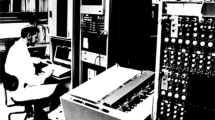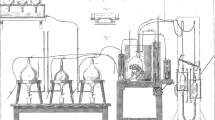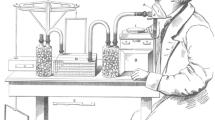Abstract
The Douglas bag technique is reviewed as one in a series of articles looking at historical insights into measurement of whole body metabolic rate. Consideration of all articles looking at Douglas bag technique and chemical gas analysis has here focused on the growing appreciation of errors in measuring expired volumes and gas composition, and subjective reactions to airflow resistance and dead space. Multiple small sources of error have been identified and appropriate remedies proposed over a century of use of the methodology. Changes in the bag lining have limited gas diffusion, laboratories conducting gas analyses have undergone validation, and WHO guidelines on airflow resistance have minimized reactive effects. One remaining difficulty is a contamination of expirate by dead space air, minimized by keeping the dead space <70 mL. Care must also be taken to ensure a steady state, and formal validation of the Douglas bag method still needs to be carried out. We may conclude that the Douglas bag method has helped to define key concepts in exercise physiology. Although now superceded in many applications, the errors in a meticulously completed measurement are sufficiently low to warrant retention of the Douglas bag as the gold standard when evaluating newer open-circuit methodology.

(Source: Hill et al. (1924))

Source: https://goo.gl/images/aGQwI3
Similar content being viewed by others
Abbreviations
- R.A.F.:
-
Royal Air Force
- WHO:
-
World Health Organisation
References
Andersen KL, Shephard RJ, Denolin H et al (1971. Fundamentals of exercise testing. World Health Organisation, Geneva
Balchum OJ, Hartman SA, Slonim NB et al (1953) The permeability of the Douglas-type bag to respiratory gases. J Lab Clin Med 41:208–280
Bartlett HL, Hodgson JL, Kollias J (1972) Effect of respiratory valve dead space on pulmonary ventilation at rest and during exercise. Med Sci Sports 4:132–137.
Bassett DR, Howley ET, Thompson DL et al (2001) Validity of inspiratory and expiratory methods of measuring gas exchange with a computerized system. J Appl Phyiol 91:218–224
Cerretelli P, Sikand RS, Farhi LE (1969) Effect of increased airway resistance on ventilation and gas exchange during exercise. J Appl Physiol 27:597–600
Chinn DY, Naruse Y, Cotes JE (1986) Accuracy of gas analysis in lung function laboratories. Thorax 41:133–137
Comba FA, Midgley AW, Monteiro W et al (2013) How long does it take to achieve steady state for assessment of resting V̇O2max in healthy men? Eur J Appl Physiol 113:1441–1447
Cotes JE, Woolmer RF (1962) A comparison between twenty seven laboratories of the results of analysis of an expired gas sample. J Physiol (Lond) 163:36p–37p
Daynes HA (1920) The process of diffusion through a rubber membrane. Proc R Soc Lond A 97:286–307
Director of Air Services (1918–1919) The permeability of airship fabrics. Tech Rep Advis Comm Aeronaut (Lond) 3:1316–37, 1338–1363
Douglas CG (1911) A method for determining the total respiratory exchange in man. J Physiol (Lond) 42:1–2
Douglas CG, Haldane JS (1906) A convenient form of gas analysis apparatus. J Hyg (Lond) 6:74–76
Douglas CG, Priestley CG (1948) Human physiology: A practical course, 3rd edn. Oxford University Press, Oxford
Haldane JS (1918) Methods of air analysis. Charles Griffin, London
Herbst R (1928) Der Gasswoffstechsel als Maß der körperlichen Leistungsfähigkeit. I. Die Bestimmung des Sauerstoffaufnahmevermögens beim Gesunden (The gas metabolism as a measure of physical fitness. I. The determination of oxygen uptake in healthy people). Dtsch Arch. Klin Med 162(1):33–50
Hill AV, Long CNH, Lupton H. (1924). Muscular exercise, lactic acid, and the supply and utilization of oxygen, part IV–VI. Proc Roy Soc (Lond) 97:84–138
Hopker JG, Jobson SA, Gregson HC et al (2012) Reliability of cycling gross efficiency using the Douglas bag method. Med Sci Sports Exerc 44:290–296
Jakeman P, Davies B (1979) The characteristics of a low resistance breathing valve designed for measurement of high aerobic capacity. Br J Sports Med 13:81–83
Johnson RE, Robbins F, Schilke R et al (1967) A versatile system for measuring oxygen consumption in man. J Appl Physiol 22:377–379
Kasch FW, Philipps WM (1965) Diffusion of CO2 in meteorogical balloons and oiled syringes. Res Quart 36:104–105
Lenox JB, Koegel E (1976) Evaluation of a new low resistance valve. J Appl Physiol 37:410–413
Lloyd BB (1958) Development of Haldane’s gas analysis apparatus. J Physiol (Lond) 143:5P–6P
McKie D (1952) Antoine Lavoisier, scvientist, economist and reformer. Constable, London
McLean J, Tobin G (2010) Historicaal. In: McLean J, Tobin G (eds) Animal and human calorimetry. Cambridge University Press, Cambridge, pp 6–23
Michaelis H, Müller EA (1942) Die Bedeutung des alveolaren CO2-Drucks für die Bestimmung des auf die Atmung entfallenden Energieverbrauches [The significance of the alveolar CO2 pressure for the determination of the energy consumption due to breathing]. Arbeitsphysiol 12:85–91
Mills JN (1951) The use of an infra-red analyser in testing the properties of Douglas bags. J Physiol (Lond) 116:22–23
Perkins JF (1954) Plastic Douglas bags. J Appl Physiol 6:445–447
Pettenkofer M (1862) Ueber die Respiration. Ann Chem Pharm 123(Suppl. 2):1–52
Pettenkofer M, Voit C (1866) Untersuchungen über den Soffverbrauch des normalen Menschen. Z Biol 2:478–573
Prout W (1813) On the quantity of carbonic acid gas emitted from the lungs during respiration at different times and under different circumstances. Thomson’s Ann Philosoph 2:328–342
Pugh LG (1958). Muscular exercise on Mount Everest. J Physiol (Lond) 141:233–261
Quinney HA, Gledhill N, Peterson S et al (1986) Accreditation of elite athlete testing laboratories in Canada. In: Reilly T, Watkins J, Borns J (eds) Kinanthropology III: Proceedings of the VIII Commonwealth International Conference on Sport, Physical Education, Dance, Recreation and Health. Spon, London, pp 233–242
Regnard P (1879) Récherches expérimentales sur les variations pathologiques des combustions respiratoires. Progrès Médicale, Paris
Regnault V, Reiset J (1849) Recherches chimiques sur la respiration des animaux. Ann de Chim et de Phys Series 3 26:299–519
Scholander PF (1947) Analyzer for accurate estimation of respiratory gases in one-half cubic centimeter samples. J Biol Chem 167:235–250
Seliger V, Pachlopniková I, Mann M et al (1969) Energy expenditure during paddling. Physiol Bohemoslov 18:49–55
Shakespear GA (1916–17) A new permeability tester for balloon fabrics. Tech Rep Advis Comm Aeronaut (Lond) 2:579–583
Shephard RJ (1955) A critical examination of Douglas bag technique. J Physiol (Lond) 127:515–524
Shephard RJ (1966) A comparison of paramagnetic and chemical methods for the determination of oxygen. Int Z angew Physiol 22:279–284
Shephard RJ (2012) A critical examination of Douglas bag technique. Med Sci Sports Exerc 44:1407
Skinner JS, Wilmore KM, Jaskolska A et al (1999) Reproducibility of maximal exercise test data in the HERITAGE family study. Med Sci Sports Exerc 31:1623–1628
Venable CS, Fuwa T (1922) The solubility of gases in rubber and rubber stock and effect of solubility on permeability. Ind Eng Chem 14:139–142
Wright GR, Sidney KH, Shephard RJ (1978) Variance of direct and indirect measurements of aerobic power. J Sports Med Phys Fitness 18:33–42
Author information
Authors and Affiliations
Corresponding author
Additional information
Communicated by Nigel A.S. Taylor.
Rights and permissions
About this article
Cite this article
Shephard, R.J. Open-circuit respirometry: a brief historical review of the use of Douglas bags and chemical analyzers. Eur J Appl Physiol 117, 381–387 (2017). https://doi.org/10.1007/s00421-017-3556-6
Received:
Accepted:
Published:
Issue Date:
DOI: https://doi.org/10.1007/s00421-017-3556-6




